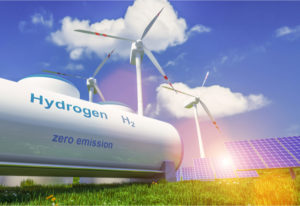
By Alexander Kirch @ Shutterstock.com
We’re in the early innings of the green energy ballgame. Don’t let windmills and solar farms blind you to the unique opportunities being unearthed over the rainbow. Read here some of Dave Sheppard’s piece in the Financial Times on hydrogen. He writes:
Hydrogen has been billed as a fuel of the future, with oil and gas companies and governments hailing it as the solution to decarbonising parts of the economy that are not easily electrified.
Yet the fuel has experienced previous false dawns, and energy majors backing hydrogen are having to step up their efforts to explain what role they see it playing, and the sectors it could transform.
Equinor, the Norwegian state-backed energy company, which rebranded from Statoil in 2018, is now mapping out a vision for investors that it believes demonstrates the fuel’s wide range of potential uses. They extend from decarbonising the steel industry to powering the ships that underpin world trade, the group says.
Irene Rummelhoff, head of marketing, midstream and processing, says Equinor’s backing of hydrogen is simple logic: as governments commit to net zero targets to curb carbon emissions, clean forms of hydrogen will become economically viable.
“It boils down to policy and political will,” Rummelhoff says. “We expect to see the hydrogen business and carbon capture and storage to kick off after 2030.”
Irene Rummelhoff, Equinor
Irene Rummelhoff, EquinorGreen hydrogen, which is made with renewable power, or blue hydrogen, which is produced using natural gas but with the resulting carbon emissions being captured and stored, will go towards replacing hydrogen that is made using less green methods (see box below).
The colours of the hydrogen rainbow
Green hydrogen Made by using clean electricity from renewable energy technologies to electrolyse water (H2O), separating the hydrogen atom within it from its molecular twin oxygen. At present, very expensive.
Blue hydrogen Produced using natural gas but with carbon emissions being captured and stored, or reused. But negligible amounts are being produced due to a lack of carbon-capture projects.
Grey hydrogen This is the most common form of hydrogen production: it comes from natural gas via steam methane reformation but without emissions capture.
Brown hydrogen The cheapest way to make hydrogen but also the most environmentally damaging due to the use of thermal coal in the production process.
Turquoise hydrogen Uses a process called methane pyrolysis to produce hydrogen and solid carbon. But it is not proven at scale, and there are concerns around methane leakage.
Action Line: Stick with me. There’s plenty in that pot of gold. But only if you’re serious.
E.J. Smith - Your Survival Guy
Latest posts by E.J. Smith - Your Survival Guy (see all)
- “What Do You Do If the Market Crashes?” - April 19, 2024
- Costco Gold Bars Sell Out Despite Premium Price - April 19, 2024
- A Wise Man’s Take on the Boston Bruins Playoff Chances - April 19, 2024
- Is Your Retirement Life a Mess? Let’s Talk - April 18, 2024
- Your Survival Guy Learns from Marie Kondo - April 18, 2024














